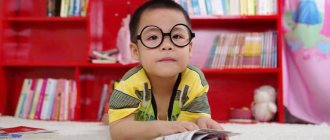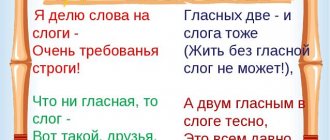Article:
Every year there is an increase in the number of children with speech disorders, and speech disorders are systemic in nature.
With general underdevelopment of speech, speech suffers as an integral system, all its components are disrupted: phonetic-phonemic side, vocabulary, grammatical structure. In complicated forms of OHP, in addition to the listed components of speech, the syllable structure of the word is additionally disrupted. The concept of “syllable structure of a word” usually means the relative position and connection of syllables in a word. Violation of syllable structure is a disorder that we, speech therapists, encounter more and more often. The formation of syllabic structure affects the success of mastering the grammatical structure of speech, mastering sound analysis, writing and reading.
There are many methods for correcting the syllabic structure of a word, but so far the authors have not been able to create one universal method.
Objectives of speech development in the Federal State Educational Standard for Education:
- development of coherent, grammatically correct dialogical and monologue speech (our coherent speech consists of two parts - dialogue and monologue. The building material for it is a dictionary and mastering the grammatical structure of speech, i.e. the ability to change words, combine them into sentences)
- formation of sound analytical-synthetic activity as a prerequisite for learning to read and write.
- development of sound and intonation culture, phonemic hearing (the child learns the stress system, pronunciation of words and the ability to speak expressively, read poetry)
Types of violations of the syllabic structure of words
1. Violation of the number of syllables:
- elision – reduction of syllables (hammer-skein)
- iteration - lowering the syllabic vowel (pinino-piano)
- increasing the number of syllables by adding a syllabic vowel in the place where there is a confluence of consonants (Slava-Salava).
2. Violation of the sequence of syllables in a word.
- rearrangement of syllables in a word (devore-tree)
- rearrangement of sounds of adjacent syllables (hebemoth-hippopotamus)
3. Distortion of the structure of an individual syllable
- reduction of a consonant cluster, turning a closed syllable into an open one (kaputa-cabbage); a syllable with a cluster of consonants into a syllable without a cluster of consonants (tul-stool).
- insertion of consonants into a syllable (lemont-lemon)
3. Anticipations
- likening one syllable to another (pipitan-captain, vevesiped-bicycle, nananas-pineapples)
4. Perseverations
- getting stuck on one syllable (pananama-panama, vvalabey-sparrow). Perseveration of the first syllable is the most dangerous, as this can develop into stuttering.
5.Contaminations - a combination of parts of two words (refrigerator-refrigerator, breadbox).
Thus, the predominance of errors expressed in the rearrangement and addition of syllables indicates a primary underdevelopment of the child’s auditory perception. A reduction in the number of syllables, the assimilation of syllables to each other, and a reduction in consonant clusters indicate a violation of the articulatory sphere.
Causes of violations of the syllabic structure of words.
An analysis of the literature on this issue indicates that there is a dependence of mastery of the syllabic structure of a word on the state of phonemic perception, articulatory capabilities, semantic insufficiency, and the child’s motivational sphere.
- insufficient development of phonemic perception and hearing;
Insufficient development of phonemic hearing and perception in children with special needs development leads to the fact that they do not independently develop readiness for sound analysis and synthesis of words, which subsequently does not allow them to independently successfully master literacy at school.
- lack of articulation capabilities;
Children have limited mobility of speech and facial muscles. The speech of such a child is unclear, blurred, due to the fact that the muscles of the articulatory apparatus are not capable of taking certain articulatory postures and are incapable of switching from one articulatory pattern to another.
- reduced level of development of optical-spatial organization;
The success of mastering reading, writing, drawing and other types of educational activities largely depends on the level of formation of spatial concepts. Impaired development of optical-spatial gnosis, a delay in the formation of spatial representations or unformed spatial representations are considered characteristic of children with OHP.
- lack of formation of rhythmic and dynamic organization of movements;
All children with OHP are characterized by general motor clumsiness. Most children have poor coordination and look motorically awkward when walking, running, or moving to music. Basic motor skills and abilities are not sufficiently formed, movements are not rhythmically organized, motor exhaustion is increased, motor memory and attention are reduced. In the absence of pronounced neurological disorders, weak regulation of voluntary activity and the emotional-volitional sphere is noted.
What comes to the fore is the immaturity of the dynamic characteristics of motor activity, expressed in the difficulties of switching from one movement to another. When performing motor tasks, severe muscle tension, difficulties in regulating muscle tone, and hidden hyperkinesis are observed.
- inability to serially process information;
Particularly difficult for children with general speech underdevelopment is the ability to consistently and coherently display certain events in speech. Children have undeveloped skills in planning and programming speech messages. Children are not capable of sequential processing of information, which causes difficulties in sound analysis and synthesis of words, combining words into phrases, and constructing a consistent logical statement.
- reduced motivational activity;
Creating positive motives is the key to successful work. It has been experimentally proven that the peculiarities of the speech activity of children with ODD are associated with the presence of motivational difficulties, according to which the child’s need for communication is not the leading one. The basic forms of communication—dialogue, monologue—are noted to be unformed. It was revealed that the lack of verbal means of communication deprives children of the opportunity to interact and becomes an obstacle to the formation of gaming interest.
Speech motivation determines the qualitative features of speech utterances, ensures the success of speech activity and the achievement of a high level of its development.
Objectives of the methodology
Based on the diagnostic results, the goal and objectives of the methodology were set.
Goal: correction of the syllabic structure of words in preschool children with general speech underdevelopment.
Tasks:
- formation of spatial concepts in children with special needs;
- development of rhythmic ability through gaming techniques and exercises;
- teaching children the correct pronunciation of words of various syllable structures;
- the emergence and maintenance of motivational activity in preschool children.
The method of correcting the syllabic structure of a word includes two stages: preparatory and main.
I. Preparatory stage.
It forms the prerequisites for the development of the syllabic structure of a word. According to recent studies, the development of the syllabic structure of a word largely depends on the characteristics of the development of non-speech processes: optical-spatial orientation, rhythmic and dynamic organization of movements, and the ability to serially process information. These non-speech processes are the basic prerequisites for the acquisition of the syllabic structure of a word. To pronounce a word, not only the correct pronunciation of isolated sounds is required, but also a series of sounds, which requires coarticulation - connections between individual articulatory structures.
The lack of spatial representations disrupts the linearity of construction and the step-by-step progression of any sensory and motor program. If we talk about speech, then the insufficiency of spatial representations is projected onto the perception and reproduction of the sequence of word elements.
Modern data speak of spatial concepts as the basis on which the entire set of higher mental processes in a child is built - writing, reading, counting. The role of the spatial factor in speech activity lies in the possibility of perceiving patterns and their further restructuring into a sequence of segments. Also important prerequisites for the formation of the syllabic structure of a word are the rhythmic and dynamic parameters, that is, the possibilities of organizing serial-sequential activity.
The work on the formation of the syllabic structure of a word is also based on the development of the child’s rhythmic ability, which is ensured by the activity of the visual, motor and skin-kinesthetic analyzers. Improving inter-analyzer connections creates the basis for sensorimotor mechanisms of syllabic rhythm of speech. Motor rhythm has an organizing influence on the development of speech mechanisms.
An indicator of the formation of optical-spatial orientation, rhythmic and dynamic construction of movements are productive types of activities associated with the practical development of space and the formation of spatial ideas.
Formation of spatial representations.
The perception and pronunciation of words of various syllabic structures is defined as the process of creating a spatial scheme in parallel with its temporal analysis. The perception and implementation of a word is carried out through the deployment of a verbal structure in time and space, with its desire for ease of pronunciation and submission to the laws of rhythm. In correctional activities, the main work on the child’s mastery of spatial relationships will be aimed at:
- formation of ideas about the space of one’s own body.
- the formation of ideas about physical space - about the location of objects using the concepts of “bottom” - “top”, “front” - “behind”, “right” - “left”.
- formation of linguistic spatial representations (seasons, days of the week, parts of the day, complex speech structures, etc.)
Development of rhythmic abilities
Any motor activity has a rhythmic component; without rhythm, the action falls apart. Motor rhythm has an organizing influence on the development of speech mechanisms. Rhythmic ability is genetically determined, and if in children with normal development it develops most actively during preschool childhood, then in children with developmental disabilities the sense of rhythm does not initially become a means of spatio-temporal organization of movements, activities and behavior due to the existing defect. Therefore, for such children, a system of correctional and developmental work is needed, aimed at the consistent formation of rhythmic ability in various types of activities.
Sequence of syllable practice
The ability to correctly reproduce various rhythms contributes to the correct reproduction of the rhythmic pattern of words, their syllabic structure, is the basis for mastering the sound-syllable structure of words in the native language, intonation, stress, and accelerates the development of other linguistic abilities, for example, word formation.
First, the syllable rhythm training is practiced:
- on straight syllables (ma, na, pa)
- on reverse syllables (ot, ut, um)
- on closed syllables (poppy, cap, boo)
- on direct and reverse syllables with hard and soft consonants.
All syllables are pronounced at a slow pace. Next, syllables with consonant clusters are practiced. This type of syllables requires separate practice. Syllables with consonant clusters are offered in the following sequence:
- open and closed (kna-ank, gna-agn)
- with oppositional consonants (fta-ftya, spy-zby)
- chains of syllables (mna-mno-mnu)
- syllables with a change in consonant position (mna-nma, nku-knu)
II. The main stage of work.
At this stage, we continue to work on the development of spatial concepts, rhythmic and dynamic activities and add the following blocks of work: exercises for the development of breathing, work on the development of fine motor skills, articulatory and bioenergoplasty, massage and self-massage, pronouncing words of an accessible class.
Breathing exercises
Breathing optimizes gas exchange and blood circulation, massages the abdominal organs, promotes overall recovery and improvement of well-being. It calms and promotes concentration.
One of the most important goals of breathing exercises is to develop the basic components of voluntary self-regulation in children. Training makes breathing simple and natural, regulated involuntarily. Breathing exercises will be aimed at developing synergy between breathing and phonation. In the process, volitionality, stability and duration of phonation exhalation, and a rhythmic change of respiratory phases are developed. The main thing is full breathing, that is, a combination of chest and abdominal breathing. Until the child learns to breathe correctly, you can put one hand on his chest, the other on his stomach (fix it with the hands of an adult on top).
It is universal to teach 4-phase breathing exercises, containing stages of equal time: inhale-hold-exhale-hold. At the beginning, each of them is 2-3 seconds with a gradual increase to 7 seconds. During the exercises, you need to ensure that the diaphragm moves and your shoulders remain calm.
Massage and self-massage
Massage is one of the non-traditional ways to organize the correctional and educational process in preschool age. With systematic massage, the reflex connections of the cerebral cortex with the muscles and blood vessels are strengthened, muscle tone is normalized, and tactile sensations are stimulated. Massage allows you to activate and synchronize the work of both hemispheres of the brain. Self-massage of the face is aimed at developing and improving memory, abstract thinking, intelligence, and speech development. Regular use of self-massage of the face helps increase a child's intelligence by 75%.
Exercises to develop fine motor skills
N.A. Bernstein: The dialectic of motor skill development lies in the fact that each subsequent performance is better than the previous one, and therefore does not repeat it. Therefore, the exercise is not repetition, but the construction of movement.
It is already a well-known fact that fine motor skills influence the development of sound pronunciation. Fine motor skills of the hands interact with higher mental functions such as attention, thinking, optical-spatial perception, imagination, observation, visual and motor memory, and speech.
Mastery of the serial organization of the articulatory act occurs when the base is ready. We create this base through the development of general and fine motor skills.
Articulation gymnastics and bioenergoplasty
Bioenergoplasty is a new direction in speech therapy work; it is a combination of movements of the articulatory apparatus with movements of the hand. According to researchers, body movements, joint movements of the hand and the articulatory apparatus, if they are plastic and free, help to activate the natural distribution of bioenergy in the body. This has a beneficial effect on the activation of intellectual activity, promotes the development of coordination and fine motor skills.
At the initial stage, children train according to the standard method in front of a mirror; the child’s hand is not involved in the exercise. In this case, the speech therapist demonstrating the exercise accompanies the demonstration with the movement of one hand. Gradually, in children, the movement of one hand (first the leading one) is connected to articulation. Gradually the second hand also joins in. Thus, the child performs an articulatory movement or holds a pose and at the same time imitates and repeats the movement of the articulatory apparatus with the movement of both hands. When hand movements are mastered, you can add eye movements.
Pronouncing words of an accessible syllabic class
When pronouncing words of an accessible syllabic class, the zone of proximal development must be constantly taken into account. That is, having collected several words from all classes, we offer them to the child for reflected repetition. We find out the level of his capabilities, and then we begin work: we pronounce words of an accessible syllabic class until the pronunciation becomes sufficiently confident. And then we add slightly more complex words, each time “stepping” into the zone of proximal development.
Next, automated words are practiced in phrases and simple sentences. Thus, the main emphasis in the correction process is precisely on the automated pronunciation of syllables and combining them in words of different syllabic structures.
Classification of the syllabic structure of a word by A. K. Markova
The syllabic structure of a word, according to Markova, is defined as an alternation of stressed and unstressed syllables of varying degrees of complexity and has four parameters:
- emphasis
- number of syllables
- linear sequence of syllables
- model of the syllable itself.
Thus, A.K. Markova identified 14 types of syllabic structure of a word and arranged them in increasing degrees of complexity.
Complication consists in increasing the number and using different types of syllables.
- Two-syllable words made from open syllables (children, owl, cotton wool)
- Three-syllable words made from open syllables (raspberry, valley, clearing)
- Monosyllabic words (house, cat, whale)
- Two-syllable words with a closed syllable at the end (sofa, banana, furniture)
- Two-syllable words with a consonant cluster in the middle of the word (bank, branch, pussy)
- Two-syllable words made from closed syllables (kompot, tulip, bear)
- Three-syllable words with a closed syllable at the end (hippopotamus, telephone, pineapple)
- Three-syllable words with consonant clusters (apple, sausage, candy)
- Three-syllable words with a consonant cluster and a closed syllable at the end (grasshopper, gardener, orange)
- Three-syllable words with two consonant clusters (matryoshka, hut, toys)
- Monosyllabic words with a consonant cluster at the beginning or words (cabinet, table, screw)
- Two-syllable words with two consonant clusters (nest, chicks, nails)
- Four-syllable words made from open syllables (turtle, piano, pinocchio)
- Four-syllable words with a combination of consonants (stop, teacher, strawberry)
Using computer games in speech therapy work
Information and communication technologies (ICT) are currently an integral part of modern preschool education. According to the new requirements of the Federal State Educational Standard for Education, the introduction of innovative technologies is intended, first of all, to improve the quality of education, increase children’s motivation to acquire new knowledge, and speed up the process of acquiring knowledge. One of the innovative areas is computer technology. The use of computer technologies in preschool education makes it possible to introduce playful moments into the process of correcting speech disorders; allow you to repeatedly duplicate the required type of exercises and speech material, without thereby suppressing the child’s interest in classes.
Computer resources allow:
- use different stimulus material;
- work at different difficulty levels
- simultaneously with speech therapy work, correct the child’s perception, memory, attention, and thinking;
- create your own didactic material, taking into account the requirements of the correctional program and the level of preparation of the children and the structure of the violation.
The use of computer technologies in the correctional pedagogical process makes it possible to rationally combine traditional and modern means and methods of teaching, thereby increasing interest in the material being studied. By playing computer games, a child learns to plan, anticipate a chain of events, and develops the ability to predict the results of actions - all this is important for the development of logical thinking.
In speech therapy work, speech therapy games can also be used to develop phonemic hearing, differentiation of sounds, sound analysis and synthesis, development of syllabic analysis, and development of the lexical and grammatical component of speech. All this can be created using Microsoft Office PowerPoint. Thanks to this program, speech therapy games are very easy and quick to create; they arouse great interest in children and a desire to practice. Therefore, the correction process goes much faster.
List of used literature:
- Agranovich Z.E. Speech therapy work to overcome violations of the syllabic structure of words in children. – St. Petersburg: Detstvo-Press, 2001;
- Babina G.V., Safonkina N. Yu. Syllable structure of words: examination and formation in children with speech underdevelopment;
- Bolshakova S. E. Overcoming violations of the syllabic structure of words in children. – M.: TC Sfera, 2015;
- Dedyukhina G.V. Work on rhythm in speech therapy practice. – M.: Iris-press, 2006;
- Krupenchuk O. I. “Comprehensive methodology for correcting violations of the syllabic structure of a word.” - St. Petersburg: Publishing house. house "Litera", 2014;
- Lynskaya M.I. Formation of speech activity in non-speaking children using innovative technologies, M. Paradigma, 2012;
- Mogileva V.N. Psychophysiological characteristics of a preschool child and their consideration when working with a computer. – M.: Academy, 2007
- Chetvertushkina N. S. Syllable structure of the word: a system of correctional exercises for children 5-7 years old. - M., 2004
1.6. Syllable. Word hyphenation rules
Words are divided into syllables. A syllable is one sound or several sounds pronounced by one exhalation push of air.
Wed: wow, wow.
1. In the Russian language there are sounds of different audibility: vowel sounds are more sonorous compared to consonant sounds.
- It is vowel sounds that form syllables and are syllabic.
- Consonant sounds are non-syllabic. When pronouncing a word, the consonant sounds “stretch” towards the vowels, forming a syllable together with the vowels.
| There are as many syllables in a word as there are vowel sounds! |
2. A syllable can consist of one sound (and then it must be a vowel!) or several sounds (in this case, in addition to the vowel, the syllable contains a consonant or a group of consonants).
Headband - o-bo-dok; country - country; night light - night light; miniature - mi-ni-a-tyu-ra.
| If a syllable consists of two or more sounds, then it must begin with a consonant! |
3. Syllables can be open or closed.
- Open syllable ends with a vowel sound.
Wow, country.
- Closed syllable ends with a consonant sound.
Sleep, lay-ner.
- There are more open syllables in Russian. Closed syllables are usually observed at the end of a word.
Compare: no-chnik (the first syllable is open, the second is closed), o-bo-dok (the first two syllables are open, the third is closed).
- In the middle of a word, the syllable usually ends in a vowel sound, and the consonant or group of consonants that comes after the vowel usually ends in the following syllable!
No-chnik, dammit, announcer.
Note!
Sometimes two consonants can be written in a word, but only one sound, for example: get rid of [izh:yt']. Therefore, in this case, two syllables stand out: i-zhit. Dividing into parts according to the rules of word hyphenation, and not dividing into syllables! The same can be seen in the example of the verb to leave, in which the combination of consonants zzh sounds like one sound [zh:]; therefore, division into syllables will be - u-e-zzhat, and division into parts for transfer - leave-zhat.
Errors are especially common when highlighting syllables in verb forms ending in -tsya, -tsya.
- The division vit-sya, zhets-sya is a division into parts for transfer, and not a division into syllables, since in such forms the combination of letters ts, ts sounds like one sound [ts].
- When dividing into syllables, combinations of letters ts, ts go entirely to the next syllable: vi-tsya, zhmy-tsya.
- In the middle of a word, closed syllables can only form unpaired voiced consonants: [j], [р], [р'], [л], [л'], [м], [м'], [н], [н' ].
May-ka, Sonya-ka, so-lom-ka.
Note!
When combining several consonants in the middle of a word: 1) Two identical consonants necessarily go to the next syllable.
Oh, leak, yes.
2) Two or more consonants usually extend to the next syllable.
Sha-pka, equal.
The exception is combinations of consonants in which the first is an unpaired voiced voice (letters r, r, l, l, m, m, n, n, th).
Mark-ka, dawn-ka, bul-ka, insole-ka, dam-ka, ban-ka, ban-ka, bark-ka.
4. The division into syllables often does not coincide with the division into parts of the word (prefix, root, suffix, ending) and with the division of the word into parts during transfer.
For example, the word calculated is divided into the morphemes calculated-a-nn-y (ras - prefix, count - root; a, nn - suffixes; й - ending). When transferred, the same word is divided as follows: calculated. The word is divided into syllables as follows: rasschi-ta-ny.
| Word hyphenation rules | Examples |
| 1. As a rule, words are transferred into syllables. The letters ъ, ь, й are not separated from the previous letters. | Drive away, drive away, wash away. |
| 2. You cannot move or leave one letter on a line, even if it represents a syllable. | Rim-dock; the words autumn, the name cannot be divided for transfer. |
| 3. When transferring, you cannot tear off the final consonant letter from the prefix. | Leak, spill. |
| 4. When transferring, the first consonant cannot be removed from the root. | Sprinkle, attach. |
| 5. When hyphenating words with double consonants, one letter remains on the line and the other is moved. | Ran-niy, terror, van-na. |
| 6. The letter ы after the prefix cannot be separated from the root, but the part of the word starting with the letter s should not be transferred. | Once again, say. |
Exercises for the topic “1.6. Syllable. Word hyphenation rules"
►





